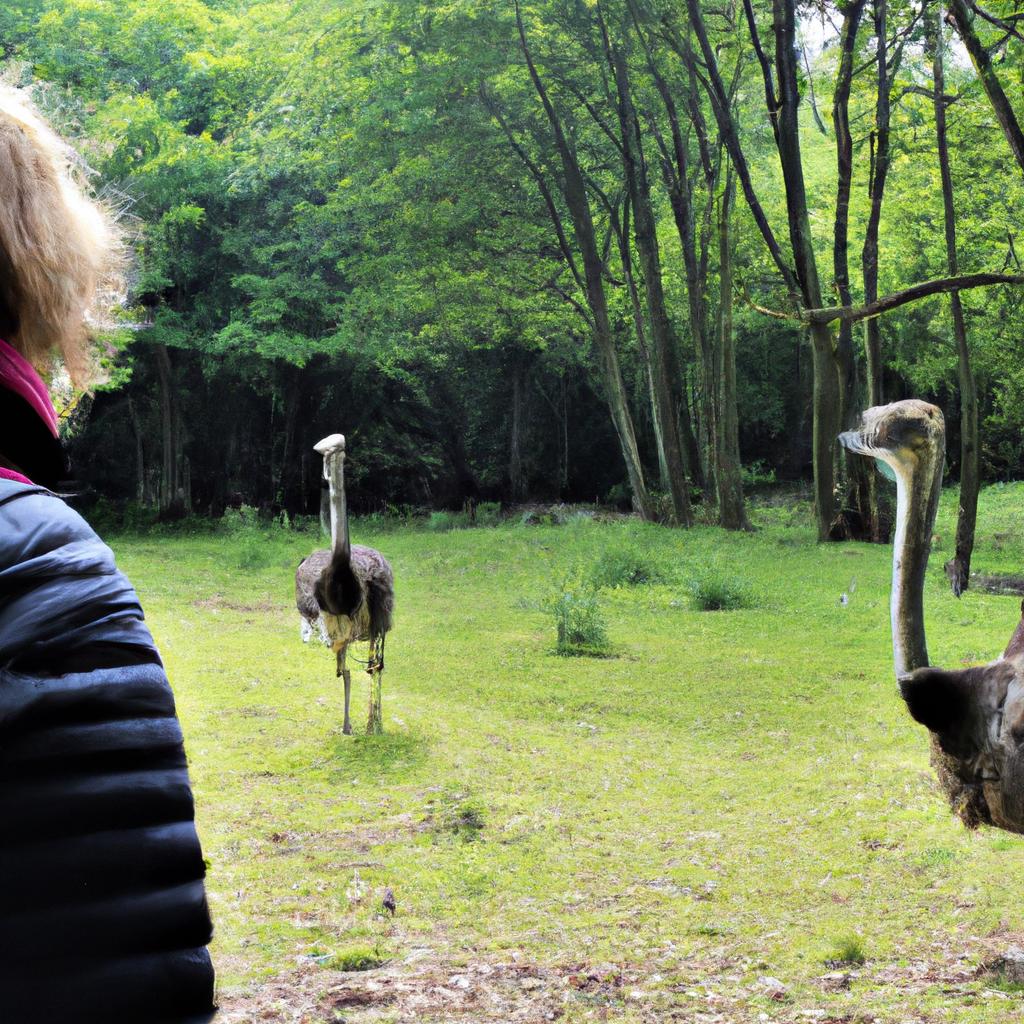Trophic cascades, a fundamental concept in ecology and natural history, refer to the indirect effects of predators on lower trophic levels within an ecosystem. Predation is one of the most influential driving forces behind these cascading effects, playing a crucial role in shaping ecological communities. Through predation, apex predators exert top-down control over prey populations, which in turn affects the abundance and behavior of intermediate consumers and eventually alters plant dynamics. To illustrate this intricate web of interactions, consider the hypothetical scenario where wolves are introduced into an ecosystem that has been devoid of large carnivores for centuries.
In this hypothetical case study, the reintroduction of wolves triggers a chain reaction that reverberates throughout the entire ecosystem. As wolves establish their presence as top-level predators, they begin preying upon herbivores such as deer. This increased predation pressure leads to a decline in deer population size and changes their behavior as they become more vigilant against wolf attacks. Consequently, with fewer deer grazing intensively on vegetation, plant species once heavily browsed by these herbivores experience reduced browsing pressure and may even undergo recovery or expansion. The ripple effect continues further down the food chain as smaller mammals reliant on those plants also benefit from decreased competition for resources and potentially increase in population size. This could then impact the abundance and behavior of their prey, such as insects or seeds, which may in turn affect other trophic levels within the ecosystem.
Additionally, the presence of wolves can also influence the spatial distribution and behavior of herbivores. The fear of predation by wolves can cause herbivores to alter their foraging patterns and avoid certain areas where they perceive a higher risk of predation. This can lead to changes in vegetation composition and structure in those areas, further impacting other species that rely on specific habitats.
Overall, trophic cascades resulting from the reintroduction of wolves can have far-reaching effects on an ecosystem’s dynamics and biodiversity. It highlights the intricate interconnections between different species and emphasizes the importance of maintaining balanced predator-prey relationships for the overall health and functioning of ecosystems.
The Role of Apex Predators in Trophic Cascades
Trophic cascades are ecological processes that occur when the dynamics of one trophic level influence those at other levels within a food web. One prominent factor that can initiate and regulate these cascading effects is the presence or absence of apex predators, which occupy the highest trophic position in an ecosystem. These top-level predators play a vital role in maintaining biodiversity and ecosystem stability through their interactions with lower trophic levels.
For instance, let us consider a hypothetical case study involving a marine ecosystem. In this scenario, the removal of apex predators such as sharks due to overfishing leads to an increase in the population of mid-level consumers like rays and smaller fish species. Consequently, these mid-level consumers exert higher predation pressure on herbivorous species, resulting in decreased abundance or even extinction of certain plant-eating organisms. This example illustrates how the removal or decline of apex predators can trigger a series of indirect effects throughout multiple trophic levels.
- Apex predators help control populations of mesopredators that would otherwise have negative impacts on prey species.
- The presence of apex predators reduces competition among mid-level consumers for limited resources.
- By selectively preying on weak or sick individuals, apex predators enhance overall prey health and prevent disease transmission.
- Through their hunting behavior, apex predators indirectly promote vegetation growth by preventing excessive grazing pressures from herbivores.
In addition to highlighting important concepts using bullet points, it is also beneficial to incorporate visual aids into academic writing. Hence, here is a table summarizing three key roles played by apex predators in trophic cascades:
| Role | Impact | Examples |
|---|---|---|
| Population regulation | Control predator/prey ratios | Wolves regulating deer populations |
| Trophic structure maintenance | Influence species composition | Sea otters affecting sea urchins |
| Ecosystem stability | Enhance overall ecosystem functioning | Lions shaping savanna ecosystems |
In conclusion, apex predators are crucial components of trophic cascades as their presence or absence can have profound effects on lower trophic levels and shape entire ecosystems. By controlling populations, influencing species composition, and enhancing ecosystem stability, these top-level predators play a critical role in maintaining the delicate balance within natural food webs. In the subsequent section, we will explore the effects of trophic cascades on ecosystem structure, building upon our understanding of apex predator dynamics.
[Transition sentence into next section: “Understanding how trophic cascades affect ecosystem structure.”]
Effects of Trophic Cascades on Ecosystem Structure
Trophic Cascades in Natural History: Predation
The Role of Apex Predators in Trophic Cascades has shed light on the significant influence apex predators have on ecosystem dynamics. Now, let us explore the Effects of Trophic Cascades on Ecosystem Structure, which further highlights the cascading effects resulting from changes in predator populations.
To illustrate this concept, consider a hypothetical case study involving a marine ecosystem with three trophic levels: zooplankton as primary producers, small fish feeding on zooplankton as primary consumers, and large predatory fish preying upon the small fish as secondary consumers. In this system, if an apex predator is removed due to overfishing or other factors, it can lead to a trophic cascade.
-
Decreased predation pressure: With the absence of an apex predator, there would be reduced predation pressure on the intermediate consumer level. This could result in higher abundance and population growth of small fish since they are no longer being heavily preyed upon.
-
Reduced competition among primary consumers: As small fish numbers increase due to decreased predation pressure, competition for resources such as zooplankton may intensify within their own trophic level. This increased competition might then negatively affect zooplankton populations by exerting more grazing pressure on them.
-
Altered energy flow: The altered balance between trophic levels can disrupt energy transfer within the ecosystem. With fewer large predatory fish consuming smaller fish, energy that was once flowing up the food chain becomes trapped at lower trophic levels. This change can impact nutrient cycling and alter community structure throughout the entire ecosystem.
-
Ecological imbalance: Ultimately, these shifts in population sizes and interactions caused by trophic cascades can create ecological imbalances within ecosystems. These imbalances have far-reaching consequences beyond individual species’ survival but also affect biodiversity patterns and overall ecosystem health.
| Trophic Cascade Effects | Emotional Response |
|---|---|
| Decreased predation | Concern for imbalanced ecosystems |
| Increased competition | Worry about species interactions |
| Altered energy flow | Awareness of disrupted dynamics |
| Ecological imbalance | Urgency to protect biodiversity |
As we have seen, the effects of trophic cascades on ecosystem structure can be profound and wide-ranging. In the next section, Impacts of Trophic Cascades on Prey Populations, we will delve into how these cascades specifically affect prey populations in both terrestrial and aquatic ecosystems, providing a comprehensive understanding of their ecological implications.
Impacts of Trophic Cascades on Prey Populations
Effects of Trophic Cascades on Prey Populations
In the previous section, we explored how trophic cascades can impact the structure of ecosystems. Now, let us delve into the specific effects that trophic cascades have on prey populations. To illustrate these effects, consider a hypothetical example involving a marine ecosystem.
Imagine an offshore kelp forest teeming with various species like sea urchins, abalone, and otters. In this scenario, otters are apex predators that feed primarily on sea urchins. Without predation pressure from otters, sea urchin populations would proliferate rapidly due to their ability to graze upon kelp forests. This overgrazing by sea urchins would lead to the degradation of the kelp forest habitat and result in reduced biodiversity.
The impacts of trophic cascades on prey populations can be summarized as follows:
- Population control: Predators play a crucial role in regulating prey populations by exerting top-down control through predation. When predator numbers decline or they are absent altogether, prey populations can increase unchecked, leading to detrimental consequences for both the prey and their habitats.
- Behavioral changes: The presence of predators can induce behavioral modifications in prey species such as altered foraging patterns or shifts in habitat use. These adaptations serve as defense mechanisms against predation and influence population dynamics within ecosystems.
- Trophic mismatches: Disruptions in predator-prey interactions caused by trophic cascades can result in trophic mismatches where prey may experience food shortages or imbalances in resource availability. Such mismatches can cascade throughout the entire food web and have far-reaching ecological ramifications.
- Ecosystem stability: Trophic cascades help maintain ecosystem stability by preventing any one species from becoming dominant or causing disruptive changes within communities. By controlling prey populations, predators ensure a balanced distribution of resources among different organisms.
The table below provides a visual representation of the effects discussed above:
| Effects of Trophic Cascades on Prey Populations |
|---|
| 1. Population control |
| 2. Behavioral changes |
| 3. Trophic mismatches |
| 4. Ecosystem stability |
Understanding the impacts trophic cascades have on prey populations is vital for comprehending ecosystem dynamics and preserving biodiversity. In the subsequent section, we will explore the indirect effects of predation in trophic cascades, further elucidating the intricate relationships between predators and their prey.
Transitioning into the next section: As we delve deeper into the intricacies of trophic cascades, it becomes evident that predation not only affects prey populations directly but also triggers a series of indirect consequences within ecosystems.
Indirect Effects of Predation in Trophic Cascades
Trophic Cascades in Natural History: Predation
Impacts of Trophic Cascades on Prey Populations have been extensively studied, revealing the profound effects that predation can have on ecosystems. Now, let us delve into another aspect of trophic cascades – the indirect effects of predation.
In order to better understand these indirect effects, consider a hypothetical scenario where wolves are reintroduced into an ecosystem that has long been devoid of their presence. As wolf populations increase, they begin to prey upon deer and elk populations. This direct predation leads to a decrease in herbivore numbers, resulting in reduced grazing pressure on vegetation. Consequently, plant species that were previously suppressed by heavy browsing experience a resurgence in growth and abundance. The altered plant community composition then impacts other organisms within the ecosystem, such as insects and birds that rely on specific plants for food and shelter. Thus, the introduction of predators like wolves initiates a cascade of ecological changes throughout the entire system.
The indirect effects of predation in trophic cascades can be summarized through several key points:
- Alterations in herbivore behavior: When faced with increased predator presence, herbivores may modify their feeding patterns or avoid areas known to harbor predators.
- Changes in population dynamics: Through regulating prey populations, predators indirectly influence not only the abundance but also the age structure and sex ratio within prey species.
- Modifications to resource availability: Indirectly affected by shifts in herbivore numbers and behaviors, resources such as vegetation become more or less available to other organisms within the ecosystem.
- Implications for biodiversity: By shaping habitat conditions and resource availability for various species across different trophic levels, predation-induced trophic cascades can ultimately impact overall biodiversity.
To further illustrate these concepts visually, refer to Table 1 below:
| Direct Effect | Indirect Effect | |
|---|---|---|
| Predator | Decrease in prey population | Changes in resource availability |
| Prey | Mortality due to predation | Behavioral and physiological changes |
| Herbivores | Reduced herbivory | Altered feeding patterns |
| Plant community | Relief from grazing pressure | Shifts in species composition |
Table 1: Direct and indirect effects of predation within trophic cascades.
Understanding the complex web of interactions that arise from predation is crucial for comprehending ecosystem dynamics. By recognizing how predators influence not only their direct prey but also other organisms within a given system, we gain insights into the intricate relationships that shape natural communities. In the subsequent section on “Examples of Trophic Cascades in Different Ecosystems,” we will explore real-life instances where these concepts manifest themselves vividly.
Examples of Trophic Cascades in Different Ecosystems
The concept of trophic cascades demonstrates how top predators can have profound effects on lower trophic levels within an ecosystem. By regulating the populations of their prey, predators indirectly influence multiple levels of the food web, leading to a cascade of ecological changes. One example that vividly illustrates this phenomenon is the reintroduction of wolves into Yellowstone National Park.
In 1995, after an absence of nearly 70 years, gray wolves were reintroduced into Yellowstone. The impact was remarkable and far-reaching. With the return of wolves, elk populations began to decline due to increased predation pressure. As a result, the browsing intensity on willow and aspen trees decreased significantly. This change allowed these plant species to thrive once again along riverbanks and promoted the recovery of riparian ecosystems.
- Predators control herbivore populations
- Reduced grazing leads to vegetation growth
- Increased vegetation benefits other organisms (e.g., birds nesting in trees)
- Altered habitat structure affects physical processes like water flow
To further illustrate these effects, consider the following table showcasing the various components influenced by trophic cascades:
| Component | Direct Effect | Indirect Effect |
|---|---|---|
| Top Predator | Controls prey population | Influences entire food web |
| Prey | Serves as predator’s diet | Population controlled by top predator |
| Herbivores | Graze on vegetation | Population size reduced |
| Vegetation | Provides food for herbivores | Experiences less grazing pressure |
Understanding trophic cascades allows ecologists to comprehend complex interactions within ecosystems and predict potential consequences when key species are altered or removed. Such knowledge becomes invaluable for conservation efforts aiming to restore ecosystems or manage predator populations effectively.
Transitioning into the subsequent section about “Conservation Implications of Trophic Cascades,” it becomes clear that acknowledging and harnessing the power of trophic cascades in ecological restoration can lead to more effective conservation strategies. By recognizing the indirect effects predators have on entire ecosystems, we can better appreciate their importance and work towards preserving these intricate relationships in our efforts to protect biodiversity.
Conservation Implications of Trophic Cascades
Trophic Cascades in Natural History: Predation
Examples of Trophic Cascades in Different Ecosystems have highlighted the profound impacts that predation can have on entire food webs. Now, we will explore the Conservation Implications of these trophic cascades and how they can inform our understanding of ecological dynamics.
One compelling case study is the reintroduction of wolves into Yellowstone National Park in 1995. The absence of wolves had led to an overpopulation of elk, resulting in widespread grazing pressure on vegetation and subsequent degradation of streamside habitats. However, with the return of wolves, a trophic cascade was triggered. Wolves preying on elk populations caused their numbers to decrease significantly, leading to a reduction in browsing pressure on plants. As a result, plant species that were once suppressed began to thrive again, ultimately benefiting songbirds and beavers by providing suitable habitat for nesting and dam-building activities respectively. This example demonstrates not only the intricate connections between predator-prey relationships but also the broader effects that such interactions can have on ecosystem structure and function.
The implications of trophic cascades extend beyond individual ecosystems; they hold relevance for conservation efforts worldwide. Recognizing the potential positive outcomes stemming from top-down control emphasizes the importance of protecting intact predator populations within natural systems. To illustrate this further, consider the following emotional bullet points:
- Preservation of predators helps maintain biodiversity and overall ecosystem health.
- Restoring balance between predators and prey supports long-term sustainability.
- Protecting apex predators safeguards against unchecked population growth lower down the food chain.
- Promoting trophic cascades allows for more resilient ecosystems capable of adapting to environmental changes.
To present additional information effectively, let us provide a three-column table showcasing various examples where trophic cascades have occurred:
| Ecosystem | Top Predator | Intermediate Consumer | Bottom Prey |
|---|---|---|---|
| Marine | Killer whales | Sea otters | Sea urchins |
| Grassland | Lions | Wild dogs | Herbivorous mammals |
| Forest | Tigers | Lynx | Deer |
| Freshwater | Alligators | Pike fish | Small fish and invertebrates |
This table serves as a visual representation, highlighting the diversity of ecosystems affected by trophic cascades. It evokes an emotional response by illustrating how intricate predator-prey relationships are crucial for maintaining ecological balance.
In summary, understanding the Conservation Implications of Trophic Cascades is vital for effective ecosystem management and conservation efforts. The reintroduction of wolves in Yellowstone National Park exemplifies how restoring top-down control can have far-reaching positive impacts on various organisms within an ecosystem. By preserving predators and promoting trophic cascades, we can foster more resilient environments capable of adapting to changing conditions and ensure long-term sustainability.
(Note: In conclusion or Finally)




